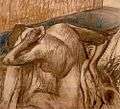After the Bath, Woman Drying Herself

After the Bath, Woman drying herself is a pastel drawing by Edgar Degas, made about 1890–95. It has been in the collection of the National Gallery, London since 1959.[1] The work is part of a series of drawings, preliminary sketches and completed works in pastels and oils by Degas from this period that depict women bathing.
Artwork øæ


The work depicts a woman sitting on white towels spread over a wicker chair, with her back to the viewer. Her body is arched and slightly twisted, creating a tension in her back, accentuated by the deep line of her backbone. One hand dries her neck with a towel, presumably after getting out of the tin bath in the corner of the room. The other arm leans out to hold onto the chair for support. The space is defined by the vertical and diagonal lines where the floor and walls meet.[2]
The drawing was made on several pieces of paper mounted on cardboard. Degas may have started with a smaller composition which he extended as he worked, requiring more paper.[3] The heavily worked pastel creates deep textures and blurred contours, emphasising the figure's movement. The artwork measures 103.5 × 98.5 centimetres (40.7 × 38.8 in).[1]
History

Edgar Degas often used photographs and sketches as a preliminary step, studying the light and the composition for his paintings. The work is part of a series of photographs, preliminary sketches and completed works in pastels and oils by Degas from this period. The series depict women dancing or bathing,[2] some showing women in awkward unnatural positions.[4] Degas, speaking about these works, said, he intended to create a feeling in the viewer: "as if you looked through a keyhole."[2] Degas included many works of female nudes bathing in the last Impressionist exhibition in 1886.[5]
Nine of Degas' pastel drawings of women at their bath were exhibited by Theo Van Gogh at Galerie Boussod et Valadon in 1888.[2] The work was shown at the Lefevre Gallery in 1950 and was bought for the collection of the National Gallery, London in 1959.[6] A less highly worked example of a similar subject is in the Courtauld Gallery,[7] and other works in the series are in many public museums.[5]
- Other similar postures
-
_(3210104411).jpg)
After The Bath, woman drying her neck (1895–98) (Musée d'Orsay, Paris)
-

Woman Washing,
-
Nude
-
.jpg)
The Breakfast after bath
-
.jpg)
After The Bath, pastel
-

After The Bath, pastel and charcoal on paper.
Influences
| Wikimedia Commons has media related to Pastels of bathers by Edgar Degas. |
The work had a considerable influence on Francis Bacon, most noticeably on his triptychs Three Figures in a Room (1964, Centre Pompidou, Paris) and Three Studies of the Male Back (1970, Kunsthaus Zürich).[6] The Tate Gallery says "For Bacon [it] was indeed something of a talisman. It epitomised Degas's approach to a larger obsession the two artists shared with the plasticity of the body, its potential for the most varied forms of articulation, in movement and repose." The work was one of three central nudes chosen by Bacon in his "The Artist's Choice" exhibition at the National Gallery in 1985, shown between Velázquez's Rokeby Venus and Michelangelo's Entombment. Art historian and curator Michael Peppiatt quoted Bacon thus: "I love Degas. I think his pastels are among the greatest things ever made. I think they're far greater than his paintings."[6]
Painting materials
The analysis of the painting materials is described in the book by Bomford et al.[8] Degas used a multitude of commercially available pastel crayons many of which consisted of several individual pigments. Predominant pigments in this painting are Prussian blue, cadmium yellow and ochres.[9]
Notes
- 1 2 Key facts | Hilaire-Germain-Edgar Degas | After the Bath, Woman drying herself | NG6295 | The National Gallery, London
- 1 2 3 4 Jones, Jonathan (30 October 2004). "How did the sexless Degas create such sexy images?". The Guardian.
- ↑ Hilaire-Germain-Edgar Degas | After the Bath, Woman drying herself | NG6295 | The National Gallery, London
- ↑ After the Bath, Woman Drying Her Back (Getty Museum)
- 1 2 Museum of Fine Arts Boston, with Comprehensive Exhibit of Edgar Degas Nudes | ARTES MAGAZINE
- 1 2 3 Francis Bacon: Back to Degas | Tate
- ↑ A&A | After the bath – woman drying herself
- ↑ Bomford D, Herring S, Kirby J, Riopelle C, Roy A. Art in the Making: Degas. London: National Gallery Company, 2004, pp. 124-29
- ↑ Edgar Degas, After the Bath, Woman drying herself, illustrated pigment analysis at ColourLex
References
- After the Bath, Woman drying herself, about 1890–5, Hilaire-Germain-Edgar Degas, National Gallery
- After the Bath, Woman Drying Her Back, photograph, The J. Paul Getty Museum
- Through a keyhole, The Guardian, 30 October 2004
- Francis Bacon: Back to Degas, Rothenstein Lecture 2011, Martin Hammer, 11 May 2012, Tate Papers Issue 17
- Museum of Fine Arts Boston, with Comprehensive Exhibit of Edgar Degas Nudes, Artes Magazine, 12 December 2011
- After the bath – woman drying herself, Courtauld Gallery
- Edgar Degas, After the Bath, Woman drying herself at ColourLex